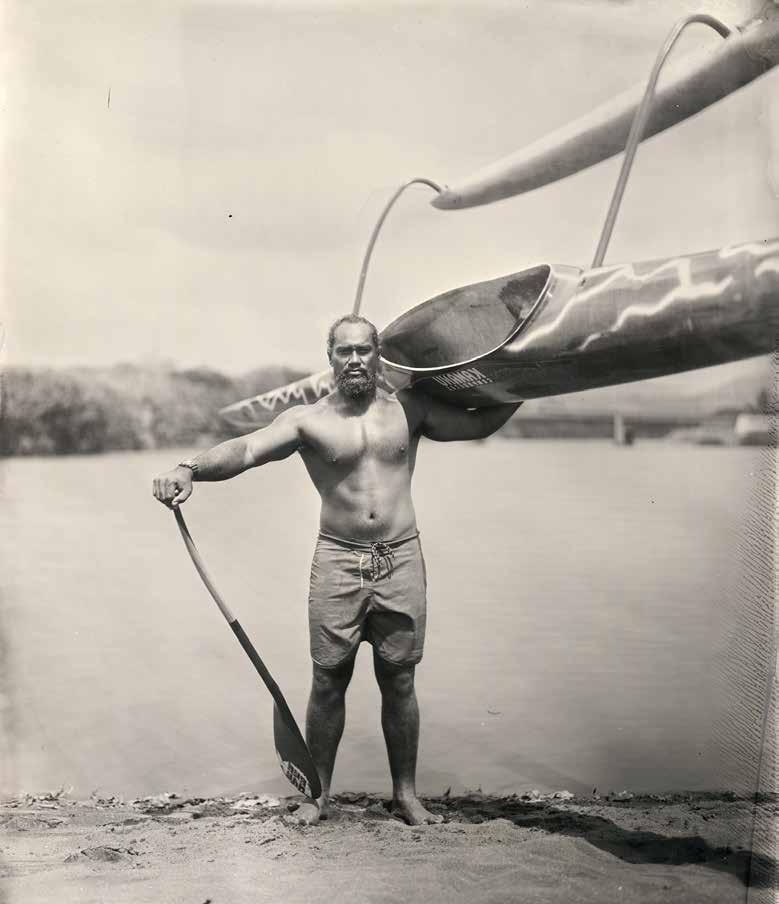
JUN · JUL · AUG 2024
LIKE A SWIM IN THE OCEAN or a walk on your favorite trail, art—whether you are creating it or experiencing it—can make you feel better. Increasingly scientists are looking at the connection between art and brain health. From the University of Texas at Dallas’ Center for Brain Health to the McCance Center for Brain Health at Massachusetts General Hospital and Harvard, the connection between brain science and creativity is a hot topic.
At the same time, museums, as community anchors, are redefining how they serve their audiences. Today health and wellness is a growing part of museums’ programming. The Honolulu Museum of Art started art therapy classes for the US Army’s Wounded Warriors program in 2010, a project that continues today. And in January we launched Art for Life—classes for adults age 55 and better that are as much about fostering community and wellness as learning art techniques.
Now I am excited to share that we have started a new arts-and-science collaboration with the O‘ahubased Brain Health Applied Research Institute (B+HARI). As part of this partnership, I have appointed B+HARI’s co-founders, internationally renowned architect Ma Ry Kim and neurologist Dr. Kazuma Nakagawa, as HoMA’s 2024 Scholarsin-Residence. The goal is to explore new ways to harness the power of art to improve the lives of individuals and the health of our communities. Read more about this new initiative on p. 12.

Strengthening community through partnerships and connecting with Hawai‘i’s people is a museum priority as HoMA approaches its 100th birthday in 2027. Our current Hawai‘i-focused exhibitions and accompanying programs— Fashioning Aloha , Kapulani Landgraf: ‘Au‘a , Ke Kumu Aupuni: The Foundation of Hawaiian Nationhood and Forward Together: African American Prints from the Jean and Robert Steele Collection are attracting new museum audiences.
We’re pleased to report that the number of visitors continues to increase over pre-pandemic numbers. In fiscal year 2023, attendance rose 70 percent from 2019, and in the first three quarters of FY2024, attendance has increased 17 percent over last year. The momentum and excitement around the museum is the direct result of your care and enthusiasm and we are incredibly grateful for your support.
We hope you make HoMA a part of your summer— enjoying the dynamic, engaging programs; the art in our cooling galleries; or simply sipping an iced latte at the Coffee Bar. It’s all possible thanks to you.
Warmly,
 HALONA NORTON–WESTBROOK Director & CEO
HALONA NORTON–WESTBROOK Director & CEO
2
Aloha HoMA Community,

Exhibitions
Ke Kumu Aupuni: The Foundation of Hawaiian Nationhood
THROUGH AUGUST 4 • This exhibition celebrates the 2022 book Ke Kumu Aupuni: The Foundation of Hawaiian Nationhood by Samuel Mānaiakalani Kamakau (1815–1876).
See 30 drawings, prints, and paintings that appear in this important publication.
Forward Together: African American Prints from the Jean and Robert Steele Collection
THROUGH SEPTEMBER 29 • A celebration of the museum’s major acquisition of prints from the Jean and Robert Steele Collection, which vastly increases HoMA’s representation of art by Black artists.
Learn how these artists shaped 20thcentury American art and visual culture.
Kapulani Landgraf: ‘Au‘a
THROUGH SEPTEMBER 29 • Kapulani Landgraf’s powerful photographic installation ‘Au‘a is a tribute to HaunaniKay Trask and lahui. See portraits of 108 Kanaka ‘Ōiwi community leaders.
Miyabi: Renaissance of Court Culture
THROUGH JULY 28 • Get an intimate look at the sumptuous, nostalgic grace of Japanese culture during the Edo period, when the court looked to its Heian past for an air of refinement.
Fashioning Aloha
THROUGH SEPTEMBER 1 • Aloha wear is more than flowers. Find out the fascinating, diverse history of this quintessential part of island life and history, from its 1930s beginnings to the present.
Go Tigers!
AUGUST 8–DECEMBER 1
This show of East Asian art depicting the symbolic tiger is a playful nod to the upcoming exhibition Home of the Tigers: McKinley High and Modern Art. HoMA’s collection is especially rich in Japanese paintings of tigers.
Kenyatta Kelechi: Laulima
AUGUST 23, 2024-JANUARY 12, 2025
Hawaiian artist Kenyatta Kelechi uses 19th-century photography techniques to create vintage-looking images that examine concepts of Indigenous identity and connection to family and place.
3
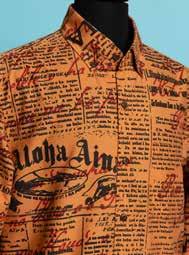

Programs
CULTURE TALK
Identity and Aloha Shirts: Kānaka, Kama‘āina, Malihini
SATURDAY, JUNE 8, 4PM • GALLERY 27
Is an aloha shirt just an aloha shirt? Learn how Kanaka ‘Ōiwi and local men use shirt aesthetics to visually communicate their identity and how haole malihini men go through a learning process in this talk by University of Hawai‘i Professor of Fashion Design and Merchandising Andy Reilly.
ART SUMMIT
Hawai‘i Triennial 2025 (HT25): ALOHA NŌ
FRIDAY, JUNE 14, 2-9PM •
DORIS DUKE THEATRE
Attend compelling talks, film screenings, exhibition tours and workshops that situate Hawai‘i at the center of high-caliber, global discourse around contemporary art and ideas, as part of the Hawai‘i Triennial’s Art Summit 2024. Make a night of it with dinner and live music at HoMA Café. For details go to hawaiicontemporary.org.

FILM & DISCUSSION
Kū I Ka Mana: Act of War
SUNDAY, JUNE 16, 2-4PM •
DORIS DUKE THEATRE
FREE WITH GENERAL ADMISSION, REGISTRATION REQUIRED.
See the 1993 film Act of War: The Overthrow of the Hawaiian Nation by Nā Maka o ka ‘Āina, then hear panelists Dr. Jonathan Kamakawiwo‘ole Osorio and Kaleikoa Ka‘eo discuss its historic significance and contemporary relevance with moderator Drew Kahu‘āina Broderick.
Connect with museum curators, artists, and creatives from Hawai‘i and around the world.
For more events and to book tickets go to honolulumuseum.org/events .

FILM
Honolulu Surf Film Festival
JULY 11-AUG 4 • DORIS DUKE THEATRE
See the latest surf films that are redefining the genre along with classic vintage selections. See p. 20 for more on the fest.
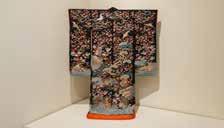
ART TALK
How Miyabi Works
FRIDAY, JULY 19, 7PM • GALLERY 3
Join University of Hawai’i Professor Emeritus of Japanese Literature Robert Huey in the exhibition Miyabi: Renaissance of Court Culture to explore how miyabi , translated as “courtly elegance,” is achieved in traditional Japanese culture.
4
SUMMER HIGHLIGHTS
.
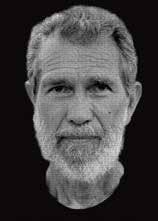
CULTURAL TALK
Kū I Ka Mana: Caring for Communities
SUNDAY, JULY 28, 2-3:30PM •
DORIS DUKE THEATRE
Panelists Lynette Cruz, Kaheleonolani Dukelow, Walter Ritte (above from Kapulani Landgraf's ‘Au‘a ) and Tammy Smith discuss challenges, strategies, and victories that surround customary practices of kapu, mālama, and aloha as a means to protect, sustain, and empower Kanaka ‘Ōiwi communities. Moderator: Mehanaokalā Hind.
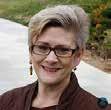
DESIGN TALK
20th-Century Aloha Wear
FRIDAY, AUG 9, 7PM •
DORIS DUKE THEATRE
Join scholar and author Dr. Linda Arthur Bradley for a talk tracing the evolution of aloha wear. A fashion specialist in 19th- and 20th-century Hawaiian textiles and aloha wear, Bradley is the author of Aloha Attire: Hawaiian Dress in the Twentieth Century .

VISITING ARTIST WORKSHOP
Chenta Laury: Exploring Transformation Through Wet-felting and Color
SATURDAY, AUG 17, 10AM-5PM •
KINA‘U COURTYARD STUDIO
Maui-based fiber artist and educator Chenta Laury leads a workshop on transforming wool fleece into 2D felted fabric art. To register, go to “special offerings” at honolulumuseum. org/art-classes.
H o MA FAMILY SUNDAY
Ku I Ka Mana / Knowledge Transcends
AUG 18, ACTIVITIES 10AM-2PM
Enjoy a day full of sights, sounds and activities that honor Hawaiian art, stories, and cultural practices. Includes performances by Project Kuleana (below), Loea Hula Kaha‘i Topolinski’s Ka Pā
Hula Hawai‘i, T-shirt silkscreening with artist Andre Perez using images from Kapulani Landgraf’s ‘Au‘a installation, tales from master storyteller Sam Kā‘ai.



DESIGN TALK In Conversation:
Designing for Change with Kūha‘o Zane & Cedric Hudson
FRIDAY, AUGUST 30, 7PM •
DORIS DUKE THEATRE
The exhibitions Forward Together and Fashioning Aloha share a common thread in how artists and designers use their practices to explore cultural identities and histories as a form of activism.
Kūha‘o Zane (top), Creative Director of Sig Zane Designs and SZKaiao, and Cedric Hudson (center), Vice President of Men’s Design at Fabletics, discuss how they use their platforms to effect social change.
5
AUG 23, 2024–JAN 12, 2025 • GALLERY 14
HAWAI‘I-BASED ARTIST Kenyatta Kelechi (b. 1990) uses the 19th-century technique of wet-plate collodion photography to examine concepts of Indigenous identity and connection to family and place. The blackand-white prints and glass and aluminum plates in Laulima document and celebrate Kānaka ‘Ōiwi (Native Hawaiian) cultural practitioners of today and their enduring respect and care for the ‘āina (land).
The highly technical collodion process relies on the correct balance of chemicals and results in hauntingly beautiful images that resemble vintage photographs. Kelechi recognizes a correlation between the wet-plate process—which is conducted on site and is vulnerable to and affected by shifting weather conditions—with a close connection to the land that is a foundation of Indigenous culture. The artist grew up in Kailua on the island of O‘ahu and although he comes from a richly varied background (his mother is Hawaiian, Chinese, and white; while his father is African American, French, and Native American), as a youth he felt
Kenyatta Kelechi: Laulima
disconnected from his Hawaiian heritage. The laborious process necessary to create a glass ambrotype or an aluminum tintype allows the artist to spend time learning from his subjects and has become a way for him to actively participate in his community.
Used by outsiders to document Native peoples of Hawai‘i during the early 1900s, Kelechi’s use of this traditional technique engages with a complex history. Acknowledging this past, the artist makes a point to learn as much as he can about his subjects and offers them greater agency in the creative process by inviting them to suggest location, clothing, pose, and composition. Laulima (literally “many hands”), illustrates the give and take between artist and subject and contrasts with the traditional idea of the photographer as observer/documentarian. Instead, Kelechi’s images express the desire to engage with and learn from community members while sharing with his subjects the authority of representation.
Kenyatta Kelechi (Hawai‘i, b. 1990).
Pa‘akai, A Labor of Love , 2022. Tintype.
6 NEW EXHIBITIONS

7

Go Tigers!
AUG 8–DEC 1, 2024 • GALLERY 3
In a nod to the exhibition Home of the Tigers: McKinley High and Modern Art , opening Sept. 27, HoMA is proud to present an artistic celebration of the tiger. The big cat has a long and important cultural significance in East Asia, starting with its role as a symbol of yin energy in the Chinese yin-yang philosophical system, which had matured in China by the Han dynasty (202 BCE-220 CE). The symbolism of the tiger, and its consequent popularity as an artistic subject, spread from China to Japan along with Chinese classical literature and written language, and HoMA’s collection is especially rich in Japanese paintings of tigers. At the same time, virtually no Japanese artist before the premodern period had ever seen an actual tiger, and the depictions of tigers in this exhibition are imaginary, based solely on inherited tradition.
8 NEW EXHIBITIONS
Hayashi Yōsei (d. 1773). Tiger and Bamboo. Japan, Edo period, 18th century. Hanging scroll; ink on paper. Gift of W. Damon Giffard, 1958 (2502.1).
Making a Scene: Actor Prints by Kunisada
AUG 29–NOV 17, 2024 • GALLERY 21
FUNDING FOR THIS EXHIBITION IS PROVIDED BY THE ROBERT F. LANGE FOUNDATION
Utagawa Kunisada (1786–1865), also known as Toyokuni III, transformed the genres of Kabuki actor portraiture (Japanese: yakusha-e ) and depictions of beautiful women ( bijinga ) by shifting the focus of those compositions to the elaborately detailed environments surrounding his figures. Each single-sheet print that he published contains an abundance of visual information and functions as a complete composition. Many such images, however, were intended as part of a larger diptych or triptych. This rotation features examples of such multipanel prints by Kunisada, several of which are on view at HoMA for the first time.

9 GALLERY HIGHLIGHT
Utagawa Kunisada / Toyokuni III (1786–1865). The Hour of the Snake. From the series Twelve Hours with Genji. Japan, Edo period (1615–1868), 1859. Woodblock print; ink and color on paper. Gift of Junsuke Aaron Otsuka, 2018 (2018-29-03a-c).

After the Revolution: Modern Mexican Prints
Featuring rarely seen work from HoMA’s collection, After the Revolution focuses on some of the most significant figures of Mexican Modernism, the so-called Tres Grandes (Three Greats): Diego Rivera (1886–1957), José Clemente Orozco (1883–1949), and David Alfaro Siqueiros (1898–1974). Together, they helped define post-revolution Mexican identity. The Mexican Revolution (1910–17) was a decisive moment in the history and arts of Mexico. In its aftermath, the new government commissioned arts and education projects that redefined how the modern Mexican nation and its history were represented. Rivera, Orozco, and Siqueiros produced public murals in line with this endeavor. The three artists followed different styles and somewhat distinct political
philosophies. Blending Renaissance and modernist techniques, Rivera’s prints express his Marxist ideology by highlighting the dignity of Indigenous and campesino peoples. Orozco, who was more ambiguous in his feelings towards the Revolution, focused on the human cost of the almost decade-long war. In his late prints, Siqueiros—the most experimental (and politically erratic) of the three—depicted Mexican themes in an expressionistic and sometimes violent manner. Alternately emphasizing Pre-Hispanic, Mestizo, and modern values, the three artists in After the Revolution helped create an ideal of 20th-century national identity known as Mexicanidad .
Jose Clemente Orozco (Mexican, 1883–1949). The Flag 1929. Lithograph. Purchase, 1932 (9760).
AUG 8-DEC 15, 2024 • GALLERY 9 10 GALLERY HIGHLIGHT

Celebrating Faith Ringgold
HoMA mourns the loss of pioneering artist, author, and activist Faith Ringgold (1930–2024), who passed away at the age of 93 on April 13 at her home in New Jersey. Best known for her paintings, children’s books, and mixed-media fiber art pieces she termed “story quilts,” Ringgold made art that expressed personal stories and narratives relating to racial justice, gender inequalities, and African American culture and history. Her first quilt, produced in 1980, combined colorful painted elements with a quilted fabric border. With the addition of text a few years later, her mixed-media works evolved into her trademark unique style.
Twelve Ringgold prints were an integral part of the acquisition of 55 works from the Jean and Robert Steele collection. Five of them are on view through Sept.29 in Forward Together: African American Prints from the Jean and Robert Steele Collection . As former director of the David C. Driskell Center for the Study of Visual Arts & Culture of African Americans & the African Diaspora at the University of Maryland, Dr. Steele has known Ringgold for many years.
“She was a very caring, generous person,” says Steele. “She was a champion of inclusion and was willing to put herself on the line for people. There is the phrase, ‘Live as you climb,’ and she did that through her Anyone Can Fly Foundation, designed to help emerging artists get a foothold in the art world by providing them financial support. As she became successful, she was sensitive to bringing others along.”
Steele also cites Ringgold’s belief in herself. “She came up at a time in New York when Abstract Expressionism was the dominant way artists were expressing themselves, but she decided to follow her own artistic vision and stuck to that,” he says.
“In 2005, when I was director of the David Driskell Center, she developed a new body of work around jazz. She could have had the exhibition at any number of institutions, but she chose to do it at Driskell, when we were still establishing the center. It was her way to personally support the vision I had, and we presented Faith Ringgold: Mama Can Sing, Papa Can Blow . Several of the prints included in the exhibition are now part of HoMA’s collection.”
Guy Bell/Alamy 11
This is your brain on art
H o MA PARTNERS WITH B+HARI TO BREAK NEW GROUND IN ARTS-AND-SCIENCE COLLABORATION

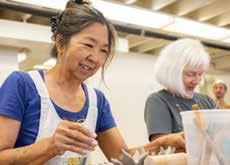
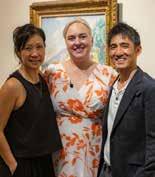

EACH WEEK, internationally known architect
Ma Ry Kim and neurologist Dr. Kazuma Nakagawa visit the museum, observing elementary school students on See Art Make Art tours, sitting in on Art for Life classes at the Art School, and meeting with Learning and Engagement Director Aaron Padilla. They are conducting research as the Honolulu Museum of Art’s first scholars-in-residence.
Kim and Nakagawa are the co-founders of the Brain Health and Research Institute (B+HARI), a pioneering organization dedicated to advancing brain health through research and practical lifestyle adjustments. They lead a multidisciplinary team that looks at insights from fields such as neuroscience, aging and longevity, indigenous cultural practices, oceanography, culinary and farming—and, of course, art—to develop solutions to problems caused by brain disease and trauma, as well as preventive measures. And their findings as scholars-in-residence will inform the new partnership between HoMA and B+HARI to develop a pilot program that promotes brain health in an art-making setting.
There is increasing evidence in rehabilitation medicine and the field of neuroscience that making and experiencing art enhances brain function by impacting wave patterns, emotions, and the nervous system. Art has also been found to raise serotonin levels.
“The museum has been a leader in art education for almost 100 years,” says HoMA Director and CEO Halona Norton-Westbrook, who first met Kim when her design and development company I-ON Group designed and fabricated the ceiling grid for the 2022 installation Rebecca Louise Law: Awakening . “By partnering with B+HARI, HoMA has the opportunity to put research into practice, and help lead the way for a new frontier of transformative, evidence-based arts and science collaborations.”
“Many people have neurological conditions, such as dementia, stroke, traumatic brain injury and brain tumors, that affect brain function. And it is commonly thought that once the brain is damaged, that’s it,” says Nakagawa, who heads the Queen’s Medical Center’s Neuroscience Institute. “But we’re learning there are many things we can do to reconnect the brain. We have so many opportunities for non-medical treatments such as art, design and music to contribute to brain health.”
Dr. Nakagawa envisions a future when internists tell patients to get exercise, get enough sleep and make art daily as part of a healthy lifestyle.
B+HARI is developing an O‘ahu brain care campus, and the hope is that HoMA will have a presence in that space. The goal, says Kim, who specializes in biophilic architecture, is to design a place where “by the mere act of coming, the brain would start to develop neuroplasticity, start to rehabilitate itself.”
As a museum, HoMA’s priority is the health and wellbeing of its community, says Norton-Westbrook. “One of the things that is exciting about this initiatve is it has the potential to create programs that can equip our community with the tools they need to be proactive in their own brain health.”
Kim points out that, “even with all the incredible science in the world, the real test for B+HARI is how it directly impacts the person in the street. This is why our work with organizations such as HoMA matters. Together we are working to bridge the critical gap between the research and the person.”
13

PAST THE ENTRANCE GATES , in the museum lobby, are a pair of elegant floral arrangements greeting HoMA visitors as soon as they arrive. Two more rest in alcoves by the Central Courtyard, while another display accents the HoMA Cafe.
Every two weeks, the museum’s famed volunteer flower team creates this drama-in-a-vase. Led by Holly Marchant and consisting of Erin Choy, Brian Choy, Joyce Tomonari, Kitty Wo, Leila Diamond, Joanne Chang, Tracie Iha, and Rosemary Eberhardt, the group continues a long-standing tradition—it dates back to 1927, the year HoMA opened as the Honolulu Academy of Arts. They take to new heights a program that has included May Moir, one of Hawai‘i’s most revered floral designers and gardeners, who was part of the group from 1950 to 1988.
“This museum is nearly a hundred years old, and those niches have been here since the inception,” says team member and museum trustee Kitty Wo. “So, I think that was part of what our founder, Anna Rice Cooke, had intended.”
With a different member leading each design, no arrangement looks the same. The group meets early on Wednesday mornings, tackling their projects with verdant leaves and dried branches strewn around them, and by 10am, finished designs are ready to enchant visitors.
Always in bloom
H o MA’S FLOWER GROUP KEEPS THE MUSEUM ALIVE WITH STUNNING FLORAL ARRANGEMENTS
Material world
The talented floral designers find inspiration everywhere, from museum exhibitions to holidays, as well as available materials, like a chef motivated by seasonal ingredients. Often they harvest flowers and greenery from their own gardens. In March, Wo, inspired by the start of spring and Caribbean heliconia from Choy’s backyard, reused anthuriums from the previous week and dried materials she had at home to create a showstopper that greeted guests with floral sunshine. The group kicked off April with a sculptural look—twisting and winding hala and bent plexiglass, and placing the green compositions in a vessel as contemporary as the botanical display.
“You can see that we don’t always use flowers,” says Erin Choy. “We also use unconventional materials.” For the group, playing around with unusual mediums, such as recycled products like corrugated cardboard and plastic six-pack rings, excites them. It’s also sometimes necessary.
“We used cardboard muffin holders once,” recalled Joanne Chang. “We were going to be busy, and we wouldn’t be able to come back to change the water out. So, we used materials that didn’t need water.”
True to their commitment to sustainability, the flower team reuses materials from past projects. In fact, many members have areas
15
in their homes for storage. They often leave the museum with plants in hand, planning to dry and later apply them to an upcoming display.
“I love the dried elements, the dried branches,” shares Wo. “There’s so much character to them. And they have many lives because we can reuse them again and again, so it’s fun to see them transformed with each arrangement.”
The most popular material with the group? Anthuriums. Besides their tropical beauty, the plants are available in many colors and lengths—a fun challenge for the flower team members to work with. They’re also practical. “Anthuriums last long,” explains Tracie Iha. “And they can withstand the heat and humidity in Hawai‘i.”
Creating arrangements, evoking feelings
Most of the team are qualified ikebana teachers specializing in Sogetsu. “It’s the youngest and most contemporary school of ikebana, so it involves a lot of greens, a lot of sculpture,” says Joyce Tomonari, who led the team for more than ten years and has 27 years of experience in Sogetsu. “Our master teachers from Japan say, ‘If you can’t make the plant more interesting, don’t cut it because nature is already so beautiful.’”
A guiding Sogetsu principle is to enhance—not overshadow—nature’s beauty, which leads the group to focus on creating movement and balance with their materials. “We like movement because it expresses more emotion to the person looking at it,” says Tomonari.
“The arrangements add to that whole immersive experience we’re looking for—seeing and feeling with all our senses,” says Wo. She also notes that the floral presentations offer a unique and memorable experience for many visitors, showcasing the lush greenery of Hawai‘i in a way they might not have seen before.
“When you come into the museum, you know you’re somewhere different,” says Wo. “You know you’re in Hawai‘i. The whole idea of a museum that embraces the outdoors, I think that is something we incorporate with the flowers.”

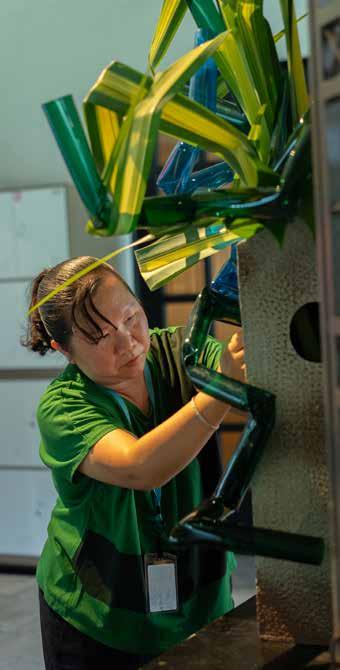 TOP LEFT Kitty Wo and Joyce Tomonari at work on a Wednesday morning.
TOP LEFT Kitty Wo and Joyce Tomonari at work on a Wednesday morning.
16
BOTTOM Joanne Chang puts finishing touches on an arrangement.


Consul General of Japan visits HoMA
HoMA was honored to welcome new Consul General of Japan in Honolulu Yoshinori Kodama in March. He met with HoMA Director Halona Norton-Westbrook and got a tour of the Japan Gallery and Robert F. Lange Foundation Gallery of Japanese woodblock prints with Asian Art Curator Shawn Eichman and Curator of Japanese Art Stephen Salel. The Consul General was impressed by the museum’s collection and hopes more Japanese visitors to Hawai‘i make the museum a part of their trip.
ABOVE Consul General of Japan in Honolulu Yoshinori Kodama and Halona Norton-Westbrook
OPPOSITE LEFT Gift print artist Kandi Everett, Alejandra Rojas Silva and Denise Karabinus at the opening reception of the Honolulu Printmakers Annual Juried Exhibition.
RIGHT, PICTURED LEFT TO RIGHT Crystal Armstrong, ‘Iolani art teacher Beth Reilley, Robb Armstrong, HoMA Director of Curatorial Affairs Catherine Whitney, HoMA Associate Director of Learning and Engagement Christine Boutros and Trustee Robert Steele.
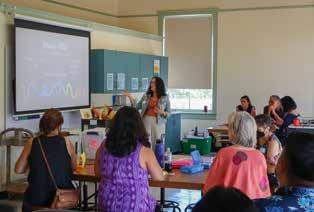
HoMA has long partnered with the Hawai‘i State Department of Education. Our comprehensive educator programs are transformative experiences for DOE teachers. This summer the museum plays a key role in the DOE’s inaugural Fine Arts Conference, being held in June and July on Maui, Kauai, Hawai‘i, and O‘ahu, to offer professional development for elementary and fine arts teachers.
As one of the hosts and facilitators, HoMA will provide workshops and break-out sessions on how to use object-based learning for close observation and critical thinking; the principles of Teaching Artistic Behaviors; strategies to use art and mindfulness in support of social emotional learning; and understanding and integrating the elements of art in curriculum. Mentors from the museum’s popular Soundshop program will also offer a hip-hop music workshop.
“This signifies our commitment to art in the schools and the strong partnership we’ve developed with the DOE over nearly a decade,” says Director of Learning and Engagement Aaron Padilla. “By working directly with teachers, they not only become more adept in utilizing art in their classrooms, they also become strong advocates of the museum. The impact is exponential and the work we do together greatly outweighs what we could ever do alone.”
18 MUSEUM NEWS
HoMA hosts DOE’s first Fine Arts Conference
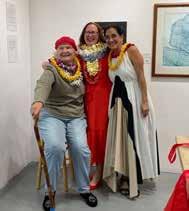
HoMA curator juries
Honolulu
Printmakers annual show
The Honolulu Printmakers, one of the oldest printmaking organizations in the country, invited Alejandra Rojas Silva, HoMA’s works on paper, photography and new media fellow, to jury its 96th Annual Juried Exhibition, which was held April 5 to 26. She selected 75 works from 276 submissions by 89 artists.
“I wanted to show a slice of what is happening in Hawai‘i today in terms of printmaking, so I tried to choose as many mediums, styles, and themes as I could and evaluate each work on its own terms,” she says.
“Alejandra Rojas Silva selected prints that celebrate tradition and make us excited about our future,” says Honolulu Printmakers director Denise Karabinus. “She carefully considered the placement of each work based on themes that thoughtfully connected so that as you move through the show the images are in quiet conversations with each other.”
Both women are especially pleased that 13 prints came from neighbor islands, and six works are by students or recent university graduates.
Rojas Silva was especially impressed with the commitment of Honolulu Printmakers supporters, who transformed an unused space of Downtown Art Center into a gallery in one week. “I thought it would be impossible,” she says. “It was moving to see the power of community in action.”
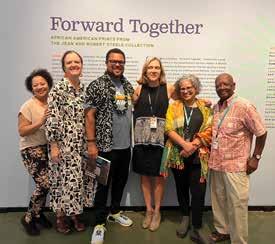
Forward Together has star power
Since it opened in January, the exhibition Forward Together: African American Prints from the Jean and Robert Steele Collection has welcomed some distinguished guests. In February, cartoonist Robb Armstrong, artist in residence at ‘Iolani School, and his wife Crystal explored the exhibition with Bob Steele. Armstrong was a protegé of Peanuts creator Charles Schulz, and most recently co-wrote the script for Snoopy Presents: Welcome Home, Franklin (to whom Schulz gave the last name of Armstrong in Robb’s honor). Then a few days later, a part-time Honolulu resident and art collector (who prefers not to be named) was scheduled to see the show with Steele, and at the last minute brought along artist Mark Bradford (his work was in the 2020 exhibition 30 Americans ).
A passionate educator, Steele, who is a HoMA Trustee, has tirelessly led tours of Forward Together . He offers personal insight into the works that he and his wife gifted to the museum to increase visibility and representation of artists who have played an important role in shaping American visual culture.
19

Hawaiian Fisherman gets a glow up
For three weeks, starting at the end of January, painting conservator Kathryn Harada applied her skills to Lionel Walden’s 1924 painting Hawaiian Fisherman . After having her clean and restore A Musical Conversation by Pieter de Hooch in 2022, Head of Collections Kyle Swartzlender wanted to next have a work from the Arts of Hawai‘i Collection conserved.
Working in a studio in the Art School, Harada removed yellowing varnish and cleaned up the painting, and in-painted losses and retouched past conservation work. Her skills revealed previously hidden colors and rays of light, as well as the fisherman’s red malo.
Conservation projects like this one rely on donors to the museum’s Annual Fund. HoMA is grateful to everyone who has given to the museum this year. With your financial support, HoMA can continue to steward its collection and the Arts of Hawai‘i for years to come.
Honolulu Surf Film Festival rolls in July 11
The Honolulu Surf Film Festival returns to the Doris Duke Theatre July 11 to August 4 for its 15th edition with a robust lineup of global shorts and features.
Theatre Manager and Programmer
Sarah Fang and HoMA thank this year’s festival committee members Manny Aloha and Crystal Thornburg-Homcy for their dedication in identifying the best in new and classic films for the event.
This year’s festival design is by Hiloborn, Los Angeles–based artist Aaron Kai, noted for his wave art. Get your T-shirt in the HoMA Shop before they sell out! Visit honolulumuseum.org for official selections and showtimes.
20
ILLUSTRATION BY AARON KAI MAJOR SUPPORT FROM Honolulu Museum of Art Doris Duke Theatre JULY 11–AUGUST 4, 2024 myhoma.org/hsff MUSEUM NEWS

CeCe Wire:
Art School’s new jewelry and metals teacher
With a name like CeCe Wire, HoMA’s new teaching artist was bound to become a metalsmith. Nationally recognized, she literally wrote the book on metal clay (really, it’s on Amazon and titled Metal Clay for Jewelry Makers ).
Wire first came to Hawai‘i in 1987, and over the next decade, she joined Hawai‘i Craftsmen, overseeing its statewide exhibition, and also served as the Mililani Town Association’s director of arts and crafts.
Then she moved to Colorado where for the past 27 years she taught jewelry and metalsmithing at the University of Northern Colorado. She ran the school’s galleries and taught many future art teachers. “I feel this is my legacy that I want to leave behind—to teach the next generation of art educators,” says Wire.
In 2023, Wire saw the position of jewelry and metals teacher at the Art School was open and she jumped at the opportunity.
“Metalsmithing is very popular in Hawai‘i and HoMA has the best metalsmithing art studio in Hawai‘i,” she explains. “With all the advanced equipment, supplies, and materials, it’s a dream studio to work in!”
A pivotal point in her career was learning the art of metal clay—silverinfused clay that’s moldable, malleable, and lightweight. She has taught metal clay globally, written three books on the topic and uses it in her jewelry series of silos and barns.
Prospective students can “expect to be entertained,” Wire jokes (she is a big Monty Python fan). Seriously though, she says her HoMA classes are similar to what she would teach in a college-level class—a basic understanding of metalsmithing technique, not to be afraid of the torches by the end of the session, and to proudly wear their pieces home. Interested in taking one of Wire’s classes? She is teaching four during the Art School’s summer session. Registration is open through the end of June.

Art class is self care
Studies show making art has physical and mental benefits. See what it can do for you, whether you’re an absolute beginner or seasoned artist.
FALL CLASSES
START OCT 17
REGISTRATION OPENS AUG. 21
Find a class that is right for you at honolulumuseum. org/art-classes
21

When Keoki Galas was a senior at Molokai High School, he needed an elective to graduate. So in his last semester of school, he opted for an art class. Next thing he knows, his art teacher is telling him he has won a trip to O‘ahu to see his charcoal drawing on view in a student art exhibition at the Honolulu Academy of Arts (now Honolulu Museum of Art).
The varsity volleyball and basketball player was stunned. “I was the youngest of seven siblings, all of us athletic and academic, and to have an art award—it was just out of the blue.” Forty years later, Galas retired as a telecommunications technician and ballroom dance instructor and was searching online for something to do. “And there were art classes at HoMA. I retired in June and I signed up for a class in September—I was back to where my art was first displayed,” he says. Now he takes up to eight classes a quarter. “I jumped in whole body,” says Galas. “I’ve taken probably all of the mediums. I just immerse myself in art.”
Growing up on Moloka‘i, Galas’ grandfather Walter Naki instilled three things in his
Keoki Galas: Finding community through art
MEMBER SPOTLIGHT
grandchildren—be a farmer, know how to feed yourself; keep your hands busy; and be a fisherman, take care of and be attentive to the ocean. His grandfather also did street ministry, and his family built the Gospel Shoes of Christ Jesus Church when he was 10.
“So I had to learn to be observant from a very young age—look at the weather, get a feel of what’s going on with the wind, the rain, the texture of the water, the season,” says Galas. “And we learned to be out and about with grandpa and not be afraid to say what we believe. We didn’t do much art growing up, yet beauty was around us all the time.”
Galas now approaches art in the same way. “Be attentive, be encouraging, also value the people that you’re with because that’s really what matters,” he says. “I love coming to the museum and learning about art—what better place? And I love being in the frequency of artists.”
He is drawn to HoMA’s Impressionist works, citing Monet’s Water Lilies and van Gogh’s Wheat Field as favorites. In fact, he is incorporating them into his current ceramic work. “I am making large square plates and using them as a canvas, and painting van Gogh–style art on them.”
Art School Teaching Artist Amber Croppings says, “One of the things I love about working with Keoki is that he provides an example of how to allow creativity to help us grow into our best selves at any age. He helps all of us in the room to be present with our creativity, challenge our capabilities, and reminds students that learning requires creative risk-taking. He shows us through his generosity and spirit that being in community with each other can be the support system we need in the classroom and beyond.”
HoMA has been a jumping off point for Galas to Honolulu’s wider arts scene—he attended the public hearing for House Bill 1807 with classmates and was blown away by work in the Artists of Hawai‘i exhibition at Downtown Art Center. Says the sharp dresser in one of his trademark colorful long-sleeved shirts: “I’m loving that I am part of a community that helps to support each other.”
SOMETHING NEW IS COMING IN AUGUST


Look out for our new membership program— with special experiences, exclusive content and more access.

Where the art is

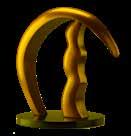
23
Allyn Bromley:
Giving to the museum for a greater good
In April, the museum welcomed the artists Enrique Chagoya and Robin Holder, who had a lively conversation about their activist art in the Doris Duke Theatre. Their well-attended appearance was thanks to the new Allyn Bromley Visiting Artist Program.
An influential figure in Hawai‘i arts, Allyn Bromley taught generations of students at Leeward Community College and at the University of Hawai‘i at Mānoa, where she was director of the Printmaking Department. She retired in 2000 as professor emeritus. She is also an acclaimed artist, with her work in the collections of Capitol Modern and HoMA. Her installation Green Piece , a cascade of prints cut into tousled blooms and vines, was included in the exhibition Natural Unnatural Supernatural in 2014, and this fall she has new and recent large-scale mixed-media works go on view in Gallery 10. At 96, Bromley continues to go to her studio—a little house in Liliha next to a stream—every day to make art.
For seven decades, the Honolulu Museum of Art has been a part of her life and work.
“It has been such a resource for my students and myself,” she says, citing how in pre-Internet Honolulu the museum was a prime way for local artists to experience what was going on in the rest of the world. “Taking students to the museum was a wonderful thing to do. It introduced them to a new environment, and changed their ideas forever. When I wanted to be inspired by the best, I went to the Academy.”
A few years ago, Bromley began planning the distribution of her assets. With her children provided for, she thought, “Why don’t I think about giving to the museum?” So she spoke with a lawyer, and “things took off from there.”
In the 1970s, Bromley attended workshops with the visiting printmakers Gabor Peterdi and William Stanley Hayter at the museum. “It was so gratifying and inspiring to work with these well-respected artists—it has stayed with me all these years,” she says. The memory inspired her to use some of her assets to create an endowment for the new visiting artist program. She never thought she would be in the position to do that. She will leave an even larger gift to the museum upon her passing.
“What I would say to people is if they don’t have family obligations, they should think about leaving assets to the museum, even as a promised gift, because it does a greater good for a larger amount of people,” advises Bromley. The museum deeply appreciates her generosity to the museum and the community.
“I support the museum in every way,” says Bromley. “I think it is doing a great job broadening and diversifying the offerings of our community. In the 1950s, my parents encouraged me to see the world. So they lent me the money to come here. When I got to Hawai‘i, I didn’t care about the rest of the world. Aside from five years in Europe in the 1960s and graduate school in Colorado, I have been here the whole time and loved it—partly because of the museum.”
24 PHILANTHROPY & COMMUNITY

25
Fashioning Aloha
In April, museum members and friends had fun wearing their favorite mu‘umu‘u and aloha shirts to the opening reception of Fashioning Aloha . The exhibition was abuzz with people taking trips down memory lane while also learning about new contemporary designs. Everyone enjoyed Hawaiian food from HoMA Café and the breezy local sounds of Summer.

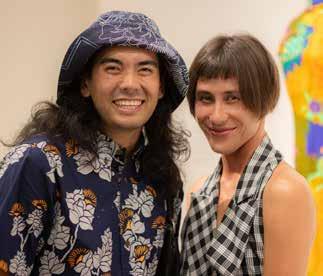


26



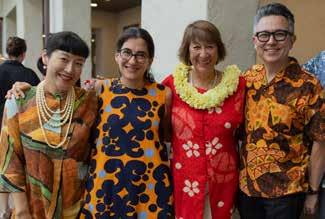

27
OPPOSITE PAGE CLOCKWISE FROM TOP RIGHT H o MA Curator of Textiles and Historic Arts of Hawai'i Tory Laitila and Nake'u Awai • David, Astrid, and Elisa Chang and Gary Payne • Rocket Ahuna and friend Puna • Roberta Oaks THIS PAGE CLOCKWISE FROM TOP LEFT Zen Yoshifuku of Sig Zane and Cassie Louie of Kahala • Aja Toscano and Taylor Okata • Lia Chee Watanabe, Alejandra Rojas Silva, Trustees Kaili Chun and Mike Watanabe • HoMA staff Melanie Joseph, Monica Garrett, Aaron Padilla, Tory Laitila, Kim Hutchison, Anjali Lee, and Hilary Sholin • Amy Benson
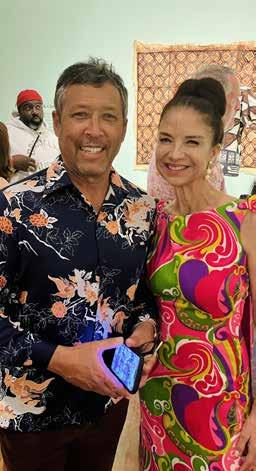

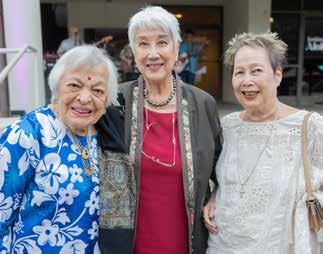



28
CLOCKWISE FROM TOP LEFT Jeremy and Janu Cassidy • HoMA Visitor Engagement Lead Timothy Pham and Senior Philanthropic Officer Cori Mackie • Linn Alber • Emma Ka‘aha‘aina at the Design Studio • Head of Collections Kyle Swartzlender, and Lead Exhibition Designer Robert Owens • Emeritus Trustee Indru Watumull, Barbara Marumoto-Coons, and Phyllis Mori

Kapulani Landgraf: ‘Au‘a
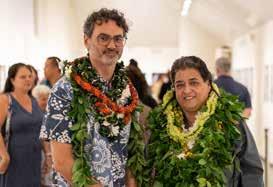
The opening reception for Kapulani Landgraf: ‘Au‘a was held on Jan. 17, the anniversary of the 1893 illegal overthrow of the Hawaiian Kingdom. Kumu Māpuana de Silva and her Hālau Mōhala ‘Ilima conducted an intimate protocol in the gallery for guests who are featured in the installation’s photographs and a second public protocol on the Central Courtyard stage. In a powerful moment, Director Halona Norton-Westbrook said, “It is important to acknowledge the complicated history of this museum. [Founder] Anna Rice Cooke was also married to Charles Montague Cooke who was part of the overthrow of the Hawaiian kingdom. We want to acknowledge that painful history as part of our reality and we don’t want to shy away from dialogue or discussion about it.” Landgraf’s thoughtprovoking work, which she calls “a collective conviction to correct the wrong,” is now an important part of the museum’s collection.
29
ABOVE Senior Curator of Modern and Contemporary Art Tyler Cann and artist Kapulani Landgraf LEFT Kumu Māpuana de Silva





30
CLOCKWISE FROM TOP LEFT Dr. Jonathan Kay Kamakawiwo‘ole Osorio
• Tatiana and Wally Fox
• Kapulei Flores and Kieran Gibson •
Dr. Aaron J. Salå • Reading names on the special installation addition made of na‘au (pig intestines) and zip ties.

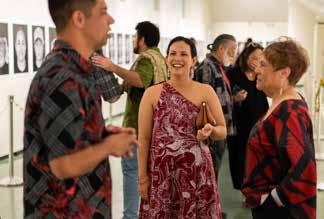
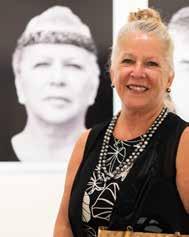


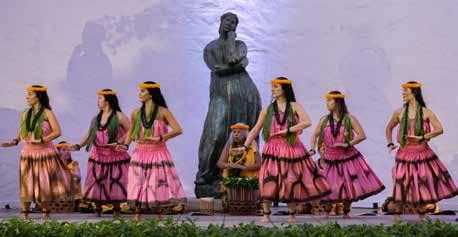
31
CLOCKWISE FROM TOP LEFT Hi‘ilei Costa and Keola Chan • Pua Case • Kumu Māpuana de Silva and Hālau Mōhala ‘Ilima • Keolani Noa • Kaulana and Kanoe Vares and Rosalie Fernandez
Corporate partners
FOUNDER ( $100,000 AND ABOVE)
DIRECTOR ($50,000–$99,999)

CURATOR ($25,000–$49,999)
32
Philanthropic Support
The museum is deeply grateful to these foundations, businesses, individuals, and governmental agencies for their generosity and commitment to the museum.
$100,000 AND ABOVE
Robert Allerton Trust
Susan & Stephen Chamberlin
City & County of Honolulu
Cooke Foundation Limited
Doris Duke Foundation for Islamic Art
$50,000–$99,999
Atherton Family Foundation
Allyn Bromley & Brian Baron
Victoria S. & Bradley L. Geist Foundation
Historic Hawaii Foundation
$25,000–$49,999
John A. Anzalone Charitable Trust
Rajiv & Ritu Batra Cartier
Clarence T. C. Ching Foundation
Herb & Nancy Conley
Harrison R. & Dorothea S. Cooke Trust
$15,000–$24,999
Margery Bronster
C.S. Wo & Sons
Frederica Cassiday
CHANEL
Priscilla Growney
Hawaii Pacific Health
Lawrence M. Johnson
Diane Koch-Weser
$10,000–$14,999
Arnold & Joji Baptiste
Ellen M. Koenig Memorial Fund
Laura Goo
Kamehameha Schools
Henry Koszewski
Robert F. Lange Foundation
Jack & Marie Lord Trust
E. A. Michelson Philanthropy
Lynne Johnson & Randy Moore
Carroll Leilani Schuman Trust
Jay & Wallette Shidler
Estate of Nancy L. Skelsey
Maurice & Joanna Sullivan
Family Foundation
John R. Halligan Charitable Fund
David & Alice Kolb
The Kosasa Foundation
Estate of Jerome K. Muller
Noreen & David Mulliken
Linda & Robert Nichols
Sharon Twigg-Smith
J.D. & Julie Watumull
Dorothea Sloggett Cooke Foundation
Peter G. Drewliner Foundation
Mark Fukunaga
Hawaiian Host Group
Ian Lind & Meda Chesney-Lind
Flora Ling & Paul Sturm
Judith D. Pyle & Wayne Pitluck
Jean E. Rolles
Michael Watanabe & Lia Chee Watanabe
John Chin Young Foundation
Sheree & Levani Lipton
Easton & Nedra Manson
Rick & Denise McGeary
David L. & Kathy Moore
Leonore & Chester O’Brien Fund
Ohuokalani Charitable Foundation
The Arthur and Mae Orvis Foundation
The Rice Partnership
Kyra Miller & Michael Zeisser
Kinjiro & Eiko Moriguchi Fund
Jordan Schnitzer
Estate of Robert C. Weible
Bonnie Rice
James H. Soong
Ed & Rae Sultan
Ruedi F. Thoeni & David B. Franklin
David Wollenberg
33
APRIL 1, 2023–MARCH 31, 2024
Honolulu Museum of Art
Director & CEO
Halona Norton-Westbrook
Board of Trustees
Chair
Josh Feldman
Vice President
Kaili Chun
Trustees
Julian K. Ako
Rajiv Batra
Mark H. Fukunaga
Priscilla Growney
Ella Qing Hou
Emeritus Trustees
Robert R. Bean
Mark Burak
Walter A. Dods, Jr.
Cecilia Doo
Helen Gary
Allison Gendreau
Elizabeth Grossman
Toshio Hara
Stephanie Hee
Michelle Ho
Vice Chair
Mike Watanabe
Secretary
Amber Strong Makaiau
Treasurer
Avi Mannis
Noreen Mulliken
Judith Pyle
Cathy Schultz
Robert Steele
Kelly Sueda
Sharon Twigg-Smith
JD Watumull
Kitty Wo
Michael Horikawa
Lynne Johnson
Robert S. Katz
Akemi Kurokawa
Violet S.W. Loo
Watters O. Martin, Jr.
Patricia J. O’Neill
Cherye Pierce
James F. Pierce
Duane Preble
Jean E. Rolles
Jay H. Shidler
Charles Sted
Charles M. Stockholm
Donna Tanoue
Ruedi Thoeni
Indru Watumull
Charles R. Wichman
Vol. 96, No. 3, HoMA magazine is published
as a benefit for the entire community:
Honolulu Museum of Art
900 South Beretania Street
Honolulu, Hawai‘i 96814
Editor: Lesa Griffith
Design Director: Anjali Lee
Photography: Alec Singer
Printing & mailing:
Edward Enterprises, Inc.
©2024 Honolulu Museum of Art, All rights reserved.
34
 Views from Within: Photographs from the Collection. On view through July 28, 2024, Gallery 9.
Views from Within: Photographs from the Collection. On view through July 28, 2024, Gallery 9.
900 S. Beretania St. Honolulu, HI 96814
808.532.8700
Wed, Thu, Sat & Sun • 10am–6pm Fri • 10am–9pm honolulumuseum.org #MyHoMA

COVER

Nonprofit Organization U.S. Postage PAID Honolulu, Hawai‘i Permit No. 119
Kenyatta Kelechi (Hawai‘i, b. 1990). Kaina Makua , 2022. Tintype.


























 TOP LEFT Kitty Wo and Joyce Tomonari at work on a Wednesday morning.
TOP LEFT Kitty Wo and Joyce Tomonari at work on a Wednesday morning.












































 Views from Within: Photographs from the Collection. On view through July 28, 2024, Gallery 9.
Views from Within: Photographs from the Collection. On view through July 28, 2024, Gallery 9.
